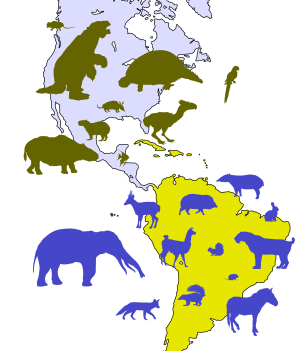Despite their ability to fly, tropical birds waited until the formation of the land bridge between North and South America to move northward.
.
 Scientists studying ancient species migration believe northern birds had the ability to colonise continents that southern species lacked. The research, published in Ecography, reveals how the ancient ‘land bridge’ of Panama, which first connected North and South America, caused an uneven species migration, leading to a new understanding of species diversity today.
Scientists studying ancient species migration believe northern birds had the ability to colonise continents that southern species lacked. The research, published in Ecography, reveals how the ancient ‘land bridge’ of Panama, which first connected North and South America, caused an uneven species migration, leading to a new understanding of species diversity today..
The continents of North and South America were historically isolated until they were abruptly joined three million years ago through the tectonic uplift of Central America and the formation of a land corridor in modern day Panama, creating a land bridge.
.
"This connection allowed an unprecedented degree of intercontinental exchange between species that had been isolated for millions of years," said lead author Brian Tilston Smith from the University of Nevada. "However the relatively poor fossil record has prevented us from understanding how the land bridge shaped New World bird communities."
.
Using molecular data and phylogenetic evidence from 11 orders, 34 families, and over 100 genera of bird species the team applied a ‘molecular clock’ to estimate the historical timing of the migration, giving a unique insight into how the ancient history of American bird migration led to present day species diversity across the equator.
.
The results reveal that while ancient birds could fly most species did not cross the water between the two isolated continents, so were subject to the same constraints as their land based mammalian counterparts. The land bridge was therefore crucial in facilitating cross continental migration.
.
"This inter-continental migration was far from even. While within the tropics around the equator exchange was equal in both directions, between the temperate zones of North and South America it was not," said Smith. "Avian lineages from the northern Nearctic regions have repeatedly invaded the tropics and radiated throughout South America. In contrast, species with South American tropical origins remain largely restricted to the confines of the tropical regions."
 Image via Wikipedia
Image via Wikipedia
.
Our study suggests the formation of the panama land bridge was crucial for allowing cross continental bird migration," concluded Smith. "We believe that the ability of species to colonise and radiate across this area represents an important and underappreciated factor to the distribution of species around the equator."
Source: Press release provided by Wiley - Blackwell http://www.wiley.com/WileyCDA/PressRelease/pressReleaseId-78217.html
Journal Reference: Brian Tilston Smith, John Klicka. The profound influence of the Late Pliocene Panamanian uplift on the exchange, diversification, and distribution of New World birds. Ecography, 2010; DOI: 10.1111/j.1600-0587.2009.06335.x
Category ›
Bird Basics
,
Nature up close
 Unknown
Unknown
 Friday, July 23, 2010
Friday, July 23, 2010










No comments:
Post a Comment